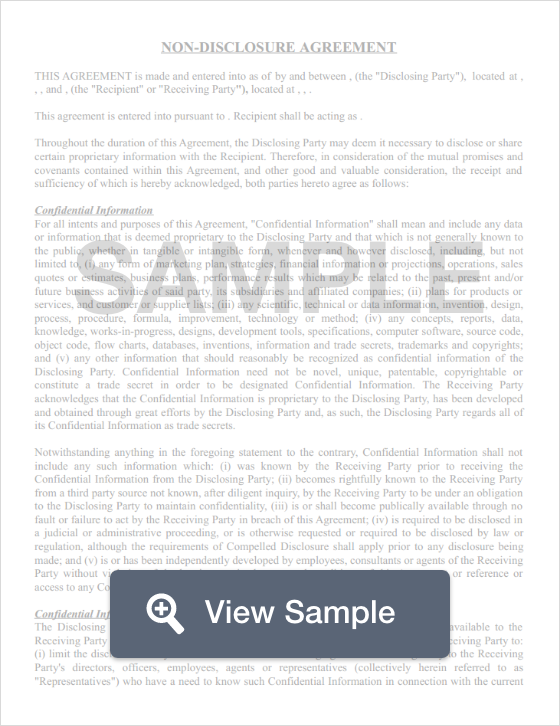What is a Non-Disclosure Agreement (NDA)?
A non-disclosure agreement (NDA), also called a confidentiality agreement, is a legally enforceable agreement that establishes confidentiality between the owner of the confidential information and the recipient.
There are two types of NDAs: A mutual non-disclosure agreement (also known as a bilateral NDA) means that both sides share sensitive information related to business practices with each other. Both parties are bound to keep that information confidential. With a non-mutual NDA, which is also referred to as a unilateral NDA, only one side shares information, and the recipient of that information is bound to confidentiality.
What Are Some Situations Where I Should Use An NDA?
A well crafted NDA helps protect sensitive information from disclosure, and also explicitly outlines what information is confidential vs what can be disclosed. Here are some common situations in which an NDA may be used to protect one or both parties.
Employees: Employees may need access to sensitive company information to do their jobs. The employee typically signs before they start their job. The NDA makes the employee promise that they will maintain the secrecy of company-specific activities that are considered a trade or business secret. It may also include a provision that says if the employee leaves, they cannot disclose such information for a specific period of time.
Business Transaction: An NDA for a business purchase or business sale is used when the seller will disclose information (this may also include financial information, customer lists, and pricing) about the business before the sale is finalized. Sometimes, showing this information, and how it is used in the business, can facilitate the sale.
Joint Venture And Partnerships: An NDA for a joint venture or partnerships allows the potential partners to share confidential business information with one another so that they can make the best decision about whether to go into business together.
Inventions: This is typically used when someone is looking for a commercial partner after they’ve invented something. This protects the inventor from having the idea, intellectual property, know-how, or prototype stolen.
Commercial Real Estate Transaction: This NDA allows the seller to share information regarding a commercial property with a prospective buyer or tenant.
What Is Typically Included In An NDA?
Parties to the agreement: Who is disclosing the private information (i.e. “the disclosing party”)? Who is receiving it? Are there any other parties involved in the agreement (e.g. affiliated company, partner, agent, etc.)?
Specification of what information is covered: What information must remain confidential? Is it only information shared between the two parties in writing? Does the agreement also cover information shared in conversation?
Exclusions: What information is excluded from the NDA? If any information shared between the two parties is publicly available, that information is automatically excluded from the agreement.
Terms of the agreement: How long will the NDA last? Remember to check your local state laws. For example, in California, an NDA is generally unenforceable, but the term limit for one in Texas would depend on if trade secrets are mentioned in the document.
Other provisions to consider include:
Employee solicitation: Can the recipient solicit or hire your employees? Are they prevented from doing so for a particular length of time?
Governing law: If there is a dispute over the NDA, how and where will the conflict be handled? Must any potential legal proceedings occur in a particular jurisdiction?
Notice: How should notices be sent to the other party? Personal delivery and/or USPS first class mail, certified, return receipt requested, postage prepaid?
Injunction: An injunction is an action (generally a court order) that prevents the other party from breaching the agreement if they try to do so.
What Is Typically Considered Confidential Information?
Common information covered in an NDA may include:
-
client information, such as names and key relationships.
-
trade secrets, such as confidential information about partnership terms.
-
investment strategy, which may include deal points and financial models.
Other common areas that are covered include: a unique invention or patented idea, a marketing plan, a plan for a new manufacturing process, a document that is being prepared for publication, or test results revealed to lab workers.
NDAs typically do NOT cover:
-
Information that is already in the public domain
-
Information received legally by an unrelated third party
-
Information where the parties agree in writing that there are no confidentiality provisions.
When Should You Not Sign an NDA?
-
Don’t sign an NDA if the terms aren’t clearly explained. Remember that confidential information, as well as business secrets, must be explained so that you understand exactly what is considered confidential.
-
Don’t sign an NDA that doesn’t clearly define a reasonable timeframe (e.g. one year) for enforcement. While 1-2 years is common, there is room for flexibility here.
When Is It Permissible to Break an NDA?
You can break an NDA any time you want, but there may be consequences similar to breaking any legal contract. Breaking it can result in you being sued for breach of contract. You may be required to pay damages.
There are also times when an NDA is considered null or void. Of course, one of the most common ways that an NDA is null or void is because it doesn’t conform to local law. You should always speak to a lawyer prior to breaking an NDA.
Legal Forms Related to a Power of Attorney
-
Living Will: A Living Will is a legal document that provides detailed, written instructions for your medical care if you become unable to make decisions on your own behalf.
-
Last Will and Testament: A Last Will and Testament is a legal form that determines how an individual’s assets, such as property, will be passed on to family members and assigned individuals upon one’s death
-
Codicil: A Codicil is a legal document that allows an individual to make updates and changes to a last will and testament.
Download a PDF or Word Template
Non-Disclosure Agreement
An increase in hiring independent contractors for help means that you need a non-disclosure agreement for your business. Also known as an NDA, this document is signed by both parties. It tells the other person that they are not allowed to disclose what they learn about your business or its processes.
 Read More
Read More
Business Plan
A business plan is a helpful document for anyone who wants to start a business. Using a business plan template, you can outline all the details for your business. Business plans include many sections including marketing, how the business will be ran, financials, and even business projection.
 Read More
Read More
Independent Contractor Agreement
Independent contracting is on the rise. Because of this, every business and every independent contractor should have a standard independent contractor agreement.This agreement is important because it defines the obligations of both parties as it relates to the project.
 Read More
Read More
Non-Compete Agreement
A non-compete agreement is important for every business. This document can be used with either independent contractors or employees. A non-compete agreement is a signed agreement between two parties that states that one party will not do something that directly competes with the current company.
 Read More
Read More

